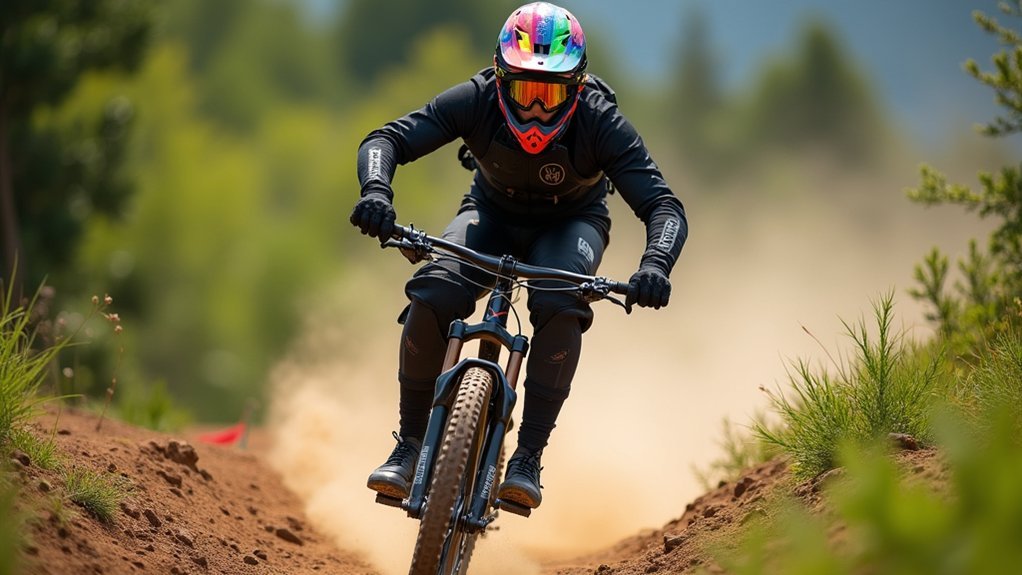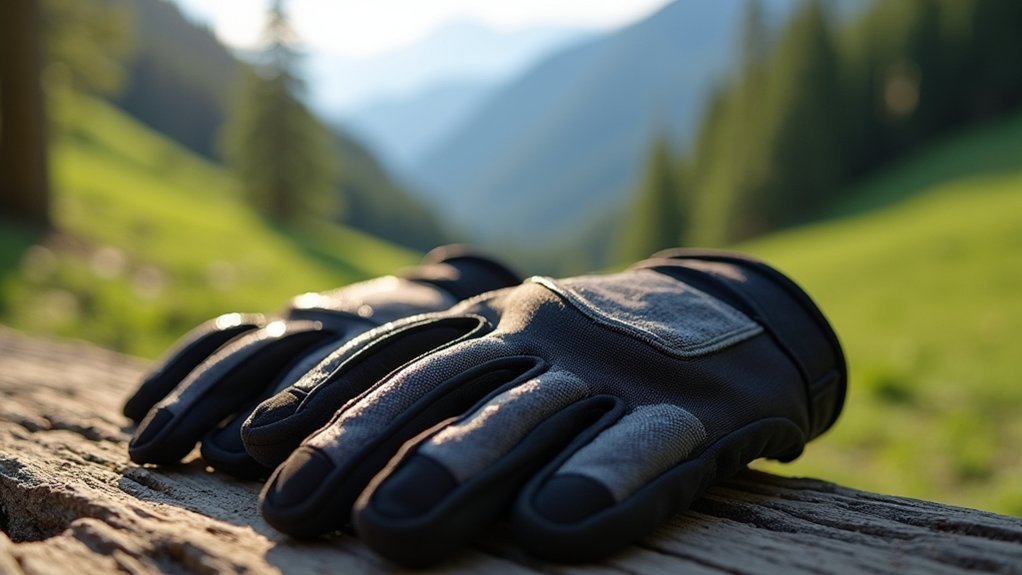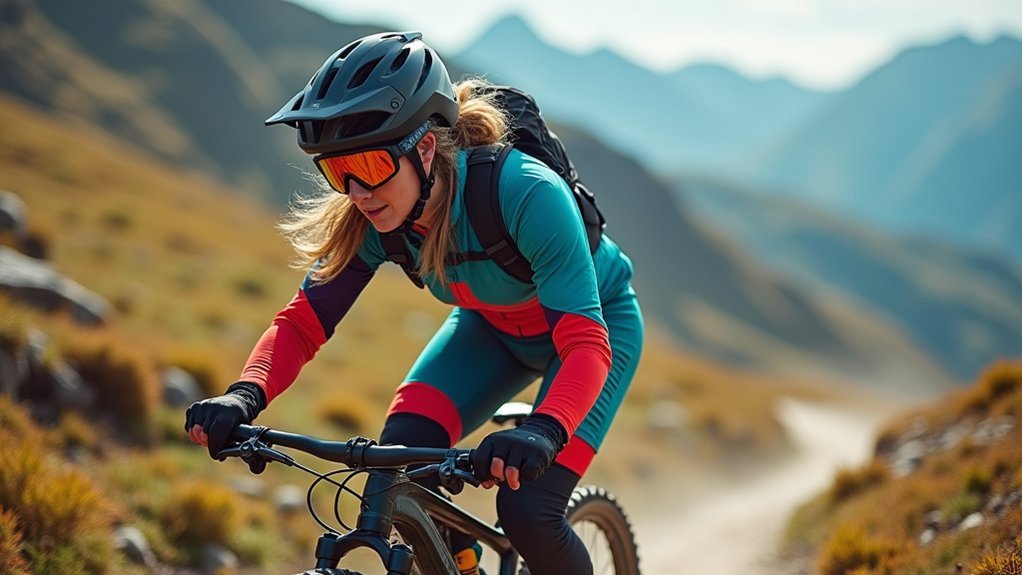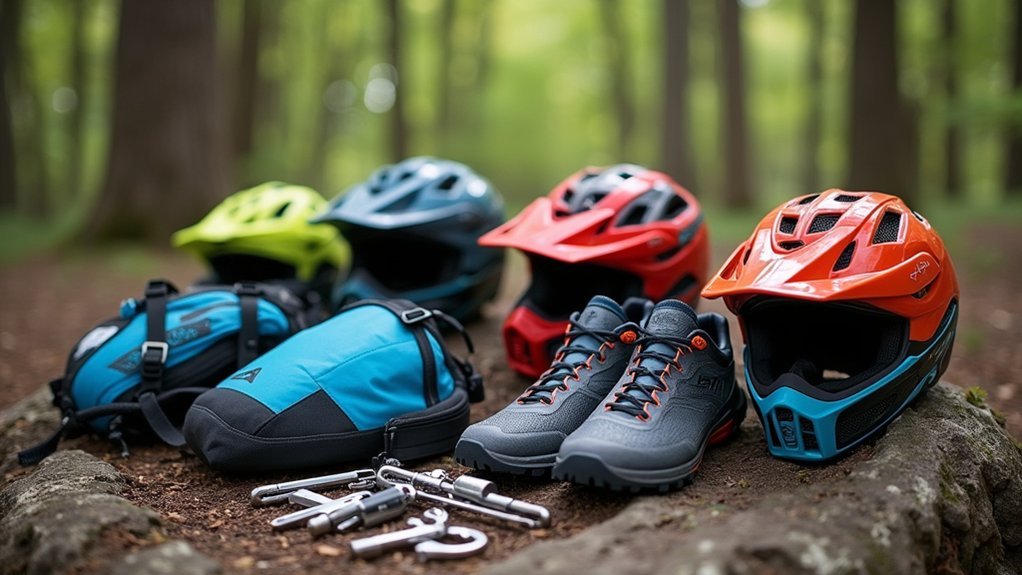Essential mountain biking gear includes a quality helmet (preferably MIPS-equipped), specialized shoes for better pedal connection, full-fingered gloves for grip and protection, and appropriate eyewear that adapts to light conditions. Don’t forget repair tools like multi-tools with chain breakers, tire levers, and compact pumps. Pack a hydration system with at least 2 liters capacity for longer rides. The right equipment transforms potential trail disasters into minor setbacks.
Protective Gear: Helmets and Body Armor for Trail Safety

When venturing onto mountain trails, protective gear becomes your first line of defense against potential injuries. A quality mountain biking helmet reduces head injury risk by 50%, with MIPS-equipped models offering superior protection against rotational forces that can damage your brain during impacts.
Choose your helmet style based on your riding: full-face for downhill adventures or trail helmets for recreational riding where ventilation matters. Remember that helmets are single-impact designs—replace them after any crash.
Your helmet choice directly reflects your riding style and should be replaced immediately after any impact.
Don’t forget body armor for complete protection. Modern knee pads and elbow pads utilize flexible materials that balance protection with comfort and breathability.
Check and maintain all protective gear regularly to guarantee it’ll perform when you need it most, keeping your mountain biking experiences thrilling rather than traumatic.
Performance Footwear: Specialized Shoes for Optimal Pedal Connection
Just as your tires connect your bike to the trail, your shoes create the critical interface between your body and the pedals. Specialized mountain biking shoes like the Five Ten Freerider Pro feature Stealth S1 rubber outsoles that deliver superior grip on flat pedals, greatly improving your control during aggressive riding.
These performance footwear options are engineered with stiff insoles that optimize power transfer while remaining comfortable for hike-a-bike sections. The flatter soles of flat pedal-specific shoes enhance pedal contact and traction, making them ideal for technical terrain.
Beyond performance benefits, proper mountain biking shoes increase safety by reducing the risk of slipping off pedals.
At around $150, investing in quality footwear greatly boosts your riding efficiency and trail enjoyment—a worthwhile investment for riders of all levels.
Hand Protection: Gloves for Grip and Impact Resistance

While your feet establish power transfer to the pedals, your hands form the other vital contact point with your bike. Mountain bike gloves are essential for both control and safety on the trail. Features like silicone grippers on fingertips dramatically enhance your grip and stability during technical descents.
Full-fingered gloves provide essential impact resistance, protecting your hands from abrasions during inevitable falls. The padded palms, typically 3mm foam, absorb jarring vibrations from rough terrain while increasing comfort on longer rides.
Never compromise on hand protection—good gloves defend against falls and dampen trail vibrations for lasting comfort.
Quality gloves use breathable materials that wick away sweat, maintaining your grip even in challenging conditions.
Don’t overlook the convenience of touchscreen compatible fingertips, allowing you to check navigation apps or answer calls without removing your gloves—keeping you connected while you stay protected.
Vision Enhancement: Eyewear Options for Variable Conditions
Clear vision on the trail can be the difference between a smooth ride and a trip to the emergency room. When tackling changing terrain, quality eyewear options that adapt to variable conditions are essential.
Smith Ruckus Sunglasses deliver full goggle protection while allowing breathability, with interchangeable lenses that adjust to shifting light. The ChromaPop technology enhances contrast, helping you spot obstacles and terrain features that might otherwise blend together.
For unpredictable weather, choose glasses offering both clear and tinted lenses to quickly adapt between bright sun and overcast skies.
Don’t overlook fit – look for grip on the temples and secure nose pads to keep your eyewear stable during rough descents.
Pit Viper Bradstrap HSOR sunglasses provide this stability while offering rugged eye protection for intense rides.
Trail-Ready Apparel: Technical Clothing for Comfort and Mobility

Proper apparel forms the backbone of any serious mountain biker’s gear collection, balancing protection with freedom of movement. When selecting technical clothing for the trails, prioritize breathable materials that wick moisture away during intense rides.
Mountain bike shorts crafted from durable nylon blends offer flexible mobility while withstanding rough conditions on challenging terrain. For longer excursions, invest in padded cycling shorts with removable chamois to reduce saddle discomfort and prevent chafing.
Jersey options range from short to long-sleeve variations, letting you adapt to changing weather while maintaining style on the trails.
Quality brands like Fox Racing and Troy Lee Designs create apparel specifically engineered for mountain biking’s unique demands, ensuring your clothing enhances rather than hinders your performance through every berm and descent.
Essential Tools: Repair Kits for On-Trail Maintenance
Your ability to fix common mechanical issues on the trail directly impacts your riding experience and safety.
Pack a thorough repair kit with tubeless plugs, spare tubes, and a quality multi-tool featuring chain breakers and various Allen keys for quick trailside fixes.
Don’t forget a reliable mini pump and patch kit—these compact essentials can transform a day-ending mechanical failure into a minor inconvenience, allowing you to continue your adventure.
Repair Kit Essentials
The well-prepared mountain biker knows that mechanical issues can strike at any moment on the trail. Your repair kit should include essential items to handle common problems without cutting your ride short.
A thorough mountain biking repair kit should contain:
- A spare inner tube and tire levers, plus a mini pump or CO2 inflator for quick tire repairs
- A multitool with hex wrenches, screwdrivers, and a chain breaker for adjustments and fixes
- Tubeless repair plugs if you’re running tubeless tires
- Spare brake pads specific to your bike’s system (Sram or Shimano)
Don’t forget to include a compact first aid kit alongside your mechanical tools.
This combination guarantees you’re prepared for both your bike’s needs and minor personal injuries that might occur during your adventure.
Field Fixes Simplified
While exploring remote trails far from civilization, being able to quickly repair common issues can mean the difference between completing your ride or facing a lengthy walk of shame.
Your repair arsenal should include a tubeless repair kit with tire plugs and reamers for quick puncture fixes. Always carry at least two spare tubes as backup if your tubeless setup fails.
A quality multi-tool with a chain breaker and various wrenches lets you make essential adjustments on the go. Don’t forget a reliable hand pump – unlike CO2 inflators, it’ll never run out of cartridges.
Complete your kit with a compact patch kit containing vulcanizing solution or pre-glued patches to extend the life of punctured tubes. With these essentials, you’ll confidently tackle most mechanical issues that arise during your adventures.
Multi-tool Selection Guide
Selecting the right multi-tool forms the backbone of effective field repairs. Your multi-tool selection should prioritize functionality without excessive weight. The Crank Brothers Multi-19 offers a thorough set of tools in a compact design, perfect for trailside repairs.
When choosing your multi-tool, make sure it includes:
- Essential hex wrenches (3mm, 4mm, 5mm, 6mm, 8mm)
- T25 Torx for various bike adjustments
- Chain breaker for fixing a broken chain quickly
- Compatibility with your specific bike components
Don’t forget to include tire levers in your repair kit—they’re vital for removing tires when replacing tubes.
Regular maintenance of your multi-tool keeps it in peak condition, ready for unexpected mechanical issues. A quality multi-tool transforms potential ride-ending breakdowns into minor delays, keeping you on the trail longer.
Hydration Solutions: Packs and Systems for Long Rides
When you’re tackling long mountain bike trails, you’ll need reliable water storage options that won’t slow you down.
Hydration packs like the Camelbak Rogue Light offer 2.5-liter capacity with easy-access drinking tubes, while hip packs such as the Fox Racing Hip Pack Slim keep weight centered for better balance while riding.
You’ll want to make certain your system includes insulated reservoirs to keep water cool and sufficient additional storage for tools and snacks during extended adventures.
Water Storage Options
Staying hydrated on the trail is essential for any mountain biker tackling long rides. Modern water storage options provide convenient solutions while maintaining your riding performance.
Hydration packs represent the most popular choice, offering hands-free access to water while providing storage for tools and snacks.
When selecting your water storage, consider:
- Capacity – aim for at least 2 liters of water for longer rides
- Fit – hip packs keep weight centered and feel less intrusive
- Insulation – some packs keep water cool during hot weather
- Accessibility – guarantee you can easily drink without stopping
Whether you choose a full backpack-style hydration pack or a more minimalist hip pack, the key is finding a system that helps you stay hydrated without compromising your riding experience or comfort.
Hydration Access Technology
Modern technology has revolutionized how mountain bikers access water during rides. Today’s hydration backpacks feature bite valves and flow control systems that allow hands-free drinking without breaking stride on technical trails. The Camelbak Rogue Light exemplifies this innovation with its streamlined profile and easy-access reservoir.
You’ll appreciate how these systems integrate storage for tools and spares along with hydration. Most packs include designated compartments for a first aid kit and trail essentials while maintaining a lightweight design that won’t compromise your balance during aggressive mountain biking.
Hip packs offer an alternative approach, keeping weight lower on your body for enhanced stability. With capacities ranging from 1.5 to 3 liters, these systems guarantee you’ll stay properly hydrated throughout extended rides while carrying everything you need.
Adaptive Equipment: Specialized Gear for Riders of All Abilities
As the mountain biking community has evolved, adaptive equipment has emerged to guarantee nobody’s left behind on the trails.
You’ll find specialized gear designed to address mobility challenges while maintaining the thrill of off-road adventures.
The accessibility revolution includes:
The trail belongs to everyone—adaptive mountain biking makes the revolution real through specialized gear and inclusive innovation.
- Handcycles and recumbent trikes with wider tires for superior stability on rugged terrain
- Adjustable seating systems that accommodate various physical abilities and comfort needs
- Electric assist features to help conquer steep inclines that might otherwise be impossible
- Protective equipment in adaptive sizes ensuring safety doesn’t compromise comfort
Organizations like the Challenged Athletes Foundation provide resources for those looking to enter the sport.
With today’s innovative adaptive mountain biking options, you can experience the freedom of the trails regardless of physical limitations.
Frequently Asked Questions
What Is the 80 Rule in Mountain Biking?
The 80 Rule means you should ride at 80% of your maximum effort to maintain endurance. You’ll preserve energy, avoid fatigue, and have reserves for climbs and technical sections during longer rides.
What Mountain Bike Gear Do I Need?
You’ll need a helmet with MIPS ($80-150), flat pedal shoes like Five Ten Freeriders ($150), a multitool like the Lezyne RAP II, a hydration pack, and a first aid kit for safe riding.
What Should I Carry on My MTB?
You’ll need a hydration pack with 2 liters of water, a multi-tool like the Crank Brothers Multi-19, a spare tube matching your wheel size, a compact first aid kit, and energy snacks for trail rides.
What to Wear as a Beginner Mountain Biker?
As a beginner mountain biker, you’ll need a properly fitted helmet ($80-150), moisture-wicking jersey, mountain bike shorts with chamois, full-fingered gloves with silicone grippers, and flat pedal shoes like Five Ten Freerider Pro for best grip.
In Summary
Armed with the right gear, you’ll transform your mountain biking experience from merely enjoyable to truly exceptional. Don’t compromise on safety, comfort, or performance. Invest in quality equipment that suits your riding style and local terrain. Whether you’re a weekend warrior or dedicated trail shredder, proper gear isn’t just about looking the part—it’s your ticket to confidence, protection, and adventure on any mountain trail you tackle.





Leave a Reply